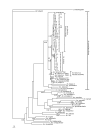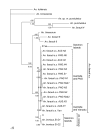Genetic diversity in two sibling species of the Anopheles punctulatus group of mosquitoes on Guadalcanal in the Solomon Islands
- PMID: 19025663
- PMCID: PMC2612007
- DOI: 10.1186/1471-2148-8-318
Genetic diversity in two sibling species of the Anopheles punctulatus group of mosquitoes on Guadalcanal in the Solomon Islands
Abstract
Background: The mosquito Anopheles irenicus, a member of the Anopheles punctulatus group, is geographically restricted to Guadalcanal in the Solomon Islands. It shows remarkable morphological similarities to one of its sibling species, An. farauti sensu stricto (An. farauti s.s.), but is dissimilar in host and habitat preferences. To infer the genetic variations between these two species, we have analyzed mitochondrial cytochrome oxidase subunit II (COII) and nuclear ribosomal internal transcribed spacer 2 (ITS2) sequences from Guadalcanal and from one of its nearest neighbours, Malaita, in the Solomon Islands.
Results: An. farauti s.s. was collected mostly from brackish water and by the human bait method on both islands, whereas An. irenicus was only collected from fresh water bodies on Guadalcanal Island. An. irenicus is distributed evenly with An. farauti s.s. (Phi SC = 0.033, 0.38%) and its range overlaps in three of the seven sampling sites. However, there is a significant population genetic structure between the species (Phi CT = 0.863, P < 0.01; Phi ST = 0.865, P < 0.01 and FST = 0.878, P < 0.01). Phylogenetic analyses suggest that An. irenicus is a monophyletic species, not a hybrid, and is closely related to the An. farauti s.s. on Guadalcanal. The time estimator suggests that An. irenicus diverged from the ancestral An. farauti s.s. on Guadalcanal within 29,000 years before present (BP). An. farauti s.s. expanded much earlier on Malaita (texp = 24,600 BP) than the populations on Guadalcanal (texp = 16,800 BP for An. farauti s.s. and 14,000 BP for An. irenicus).
Conclusion: These findings suggest that An. irenicus and An. farauti s.s. are monophyletic sister species living in sympatry, and their populations on Guadalcanal have recently expanded. Consequently, the findings further suggest that An. irenicus diverged from the ancestral An. farauti s.s. on Guadalcanal.
Figures



References
-
- Beebe NW, Bakote'e B, Ellis JT, Cooper RD. Differential ecology of Anopheles punctulatus and three members of the Anopheles farauti complex of mosquitoes on Guadalcanal, Solomon Islands, identified by PCR-RFLP analysis. Med Vet Entomol. 2000;14:308–312. doi: 10.1046/j.1365-2915.2000.00248.x. - DOI - PubMed
-
- Cooper RD, Waterson DG, Frances SP, Beebe NW, Sweeney AW. Speciation and distribution of the members of the Anopheles punctulatus (Diptera: Culicidae) group in Papua New Guinea. J Med Entomol. 2002;39:16–27. - PubMed
Publication types
MeSH terms
Substances
LinkOut - more resources
Full Text Sources
Molecular Biology Databases
Miscellaneous

